What is blister canker?
Blister canker (also known as nailhead canker) is a potentially lethal disease that primarily affects apple and crabapple trees. Other trees and shrubs grown in Wisconsin that can be affected by the disease include American elm, honey locust, hornbeam, magnolia, mountain-ash (rowan), oak, pear, and serviceberry.
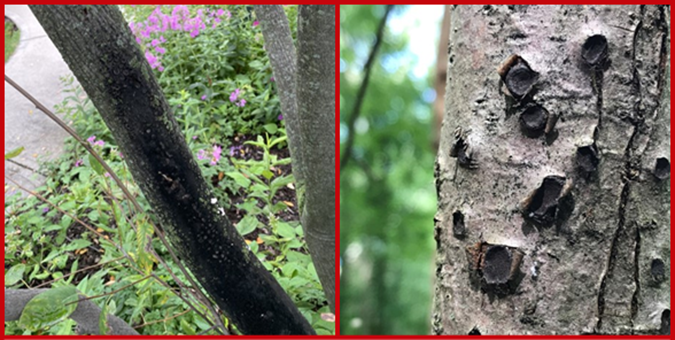
What does blister canker look like?
Symptoms of blister canker often appear as darkened, sunken areas (i.e., cankers) that extend from cracks or wounds on tree branches and trunks. These areas can be large, extending up to three feet in length. Initially, particularly in young trees, affected areas may have a mottled appearance due to a mix of diseased and healthy tissue. As the disease progresses, affected branches die and the bark peels away. Trunk infections can lead to tree death.
Within affected areas on branches and trunks, dark, round, flat structures (called stromata) form. These structures range from 1/8 to 3/8 inches in diameter. Stromata resemble nailheads and often form in clusters, giving the bark a blistered appearance. In the early stages of symptom development, blister canker may be difficult to distinguish from other canker diseases (e.g., fire blight or Nectria canker). However, the appearance of stromata helps distinguish blister canker from other diseases.
Where does blister canker come from?
Blister canker is caused by the fungus Biscogniauxia marginata, which survives on infected apple (or other) trees in both living and dead wood. Spores of the fungus (produced in the stromata) blow from tree to tree, and the fungus infects through wounds (e.g., pruning sites, broken branches). The fungus subsequently spreads under the bark.
How do I save a tree with blister canker?
Once a tree is infected by the blister canker fungus, it cannot be cured. Infected branches can be removed by pruning approximately six to eight inches below the canker. Decontaminate pruning tools after each cut by treating them for at least 30 seconds with bleach diluted to a final concentration of 0.5% sodium hypochlorite (the active ingredient) or (preferably due to its less corrosive properties) 70% alcohol (e.g., rubbing alcohol, certain spray disinfectants). If you use bleach, be sure to thoroughly rinse and oil your tools after pruning to prevent rusting. Trees with trunk infections may survive for several years, but you should remove them immediately to limit spread of the blister canker fungus. Burn (where allowed) or bury infected branches and trunk sections.
How do I avoid problems with blister canker in the future?
Blister canker often affects trees that are stressed due to drought, poor soil fertility, or (for fruit-bearing trees) excessive fruit production. Addressing these underlying issues can help prevent blister canker. Established deciduous trees (like the ones affected by blister canker) require approximately one inch of water per week from the time that they begin to leaf out in the spring, through the summer, and into the fall up until they begin to turn their normal fall color. If there is insufficient rain, apply supplemental water around the drip lines of trees (i.e., the edges of where the branches extend) using drip or soaker hoses. To address soil fertility issues, have a soil sample tested for nutrients, and fertilize based on the test results. The UW Soil and Forage Lab can assist with this testing. Thinning fruits to prevent overbearing is another practice that reduces tree stress. Ideally, fruit thinning should be carried out at the earliest stage possible, typically within three to four weeks after bloom, when the fruits are still small.
Properly prune tree species susceptible to blister canker on a regular basis so that they grow properly and are less prone to storm damage. Pruning routinely also allows for removal of smaller branches, leaving wounds that are less likely to become infected by the blister canker fungus. Pruning larger branches from older trees can create large wounds that increase the risk of infection. For details on proper tree pruning, see Pruning Deciduous Trees.
For more information on blister canker:
Contact the University of Wisconsin Plant Disease Diagnostics Clinic (PDDC) at (608) 262-2863 or pddc@wisc.edu.
Authors: Ariana Abbrescia, Brian Hudelson, and Leslie Holland, UW-Madison Plant Pathology
Last Revised: 03/06/2024
D-number: D0134
References to pesticide products in this publication are for your convenience and are not an endorsement or criticism of one product over similar products. You are responsible for using pesticides according to the manufacturer’s current label directions. Follow directions exactly to protect the environment and people from pesticide exposure. Failure to do so violates the law.
Thanks to Lisa Johnson, Vijai Pandian, and Mary Kay Thompson for reviewing this document.
A complete inventory of UW Plant Disease Facts is available at the University of Wisconsin-Madison Plant Disease Diagnostics Clinic website: https://pddc.wisc.edu.
Send a Plant Sample for Analysis
Be cautious when self-diagnosing plant health issues. Very few diseases can accurately be diagnosed by eye.
Contact the UW Plant Disease Diagnostics Clinic (PDDC), and for a small fee, clinic staff can examine a plant, determine the cause of the disease/disorder, and provide advice on how to control or prevent the issue.
Download Article





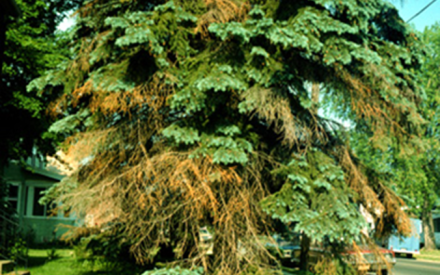 Cytospora Canker
Cytospora Canker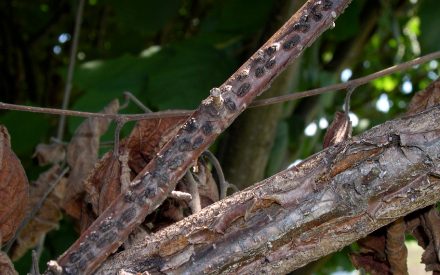 Eastern Filbert Blight
Eastern Filbert Blight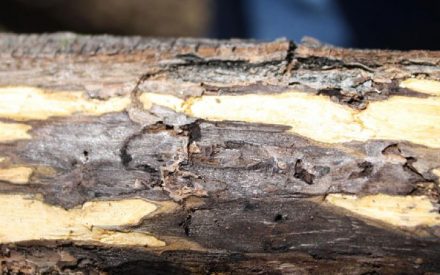 Thousand Cankers Disease
Thousand Cankers Disease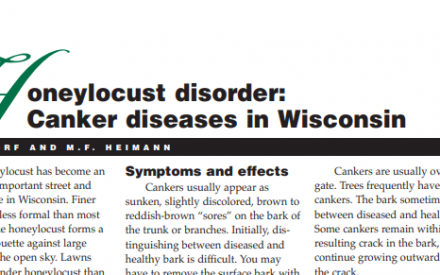 Honeylocust Disorder: Canker Diseases in Wisconsin
Honeylocust Disorder: Canker Diseases in Wisconsin


